

SLI – STEM Literacy through Infographics. Road To Information Literacy PowerPoint Presentation - ID:6513266. Road To Information Literacy An Analysis of Information Literacy Process Models Kelly Shepherd Towson UniversityInformation Literacy Models Let’s Look at the LandmarksInfoZone: Steps: Wondering Seeking Choosing Connecting Producing Judging Summary: One of the first websites to incorporate an information process model Created by: Assiniboine South School Division of Winnipeg, Canada Target Population: No information available (Lamb, 2003)Big6: Summary: The Big6 is a nonlinear strategy that can be applied to a wide variety of problems, assignments, and research projects.
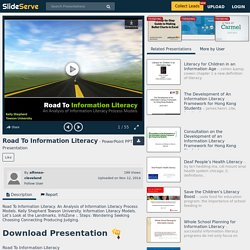
. • Steps: • Task definition • Information-seeking strategies • Location and access • Information Usage • Synthesis • Evaluation Created by: Michael E. Eisenberg Robert E. Berkowitz. 1990 Target Population: 3-12 (Hughes, 2003)Super3 Summary: The Super3 is a subset of the Big6, designed primarily for younger students. 4 Fake Sites to Teach Students Website Evaluation. As adults we (hopefully) know that not everything online is true.
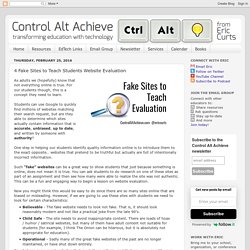
For our students though, this is a concept they need to learn. Students can use Google to quickly find millions of websites matching their search request, but are they able to determine which sites actually contain information that is accurate, unbiased, up to date, and written by someone with authority? One step in helping our students identify quality information online is to introduce them to the exact opposite… websites that pretend to be truthful but actually are full of intentionally incorrect information.
Such “fake” websites can be a great way to show students that just because something is online, does not mean it is true. What is digital fluency? Image by George Couros under CC A recent announcement from Hon. Hekia Parata signalled that digital fluency will be a key focus for Ministry centrally-funded professional learning support in 2016 (PLD Changes will lift student achievement, 23 Sept. 2015). The value of growing digitally fluent learners was signalled in the Ministry report, Future Focused Learning in Connected Communities (2014) which asked that “digital competencies be recognised as “essential foundation skills for success in 21st century society” and that they be supported by “cross-curriculum resources, a responsive assessment framework, professional development and a programme of evaluation.”
‘Digital fluency’, as a phrase, does not occur specifically in the our various curricula (NZC, Te Marautanga, Te Whāriki) or in other oft-used touchstones for learning with digital technologies. Digital literacy. What Digital Literacy Looks Like in a Classroom. Wicked EdTech - Digital Literacy. Collection of books curated based on recommendations from my PLN.
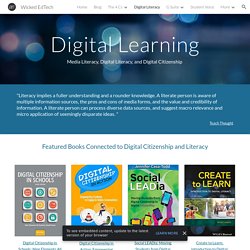
This is a resource for grade level teachers to prepare students to use technology appropriately and being mindful of the citizenship skills they already possess. Learn how to use technology and communicate online in a safe, responsible, and positive way. Learn about online safety, cyberbullying, netiquette, privacy, copyright, and the norms of appropriate, responsible behavior to help young people consider their digital footprint. Find and share resources to help students learn to analyze, evaluate, and communicate in a world with countless media sources and constant access to powerful computers. Literacy Lessons for a Digital World. Personal Narrative Digital Story.
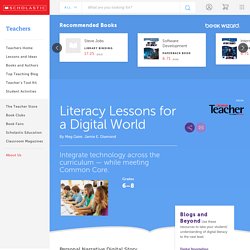
Knowing the Difference Between Digital Skills and Digital Literacies, and Teaching Both. Digital Literacy is the Most Important Lifelong Learning Tool. With the increased importance of technology in society, digital literacy is gaining recognition as the most valuable tool for lifelong learning.
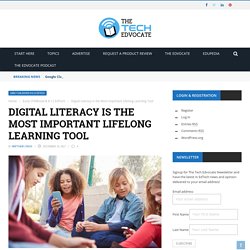
What does this mean? Essentially, as citizens of a global society, the influence of social media, technology, and online resources is massive. For children, the access to a home computer with internet increases their likelihood of college attendance exponentially. For adults, the ever evolving tech world can either help them succeed or hold them back. Society has changed over the last 15 years. Principal Ideas. Digital literacy in the classroom. How important is it? - ResourcEd. “Never before has there been a more powerful influence on human behavior, irrespective of country or culture, than the combined effect of digital technologies.”
Mervyn Eyre, executive vice president, Fujitsu Americas The digital world offers tremendous benefits to us all. It provides platforms that allow us to connect and collaborate. It opens up opportunities to learn about new and important issues, and it empowers innovation in ways that were unimaginable just a few years ago. Today, the advancement of technology has permeated every aspect of our lives. 8 Essential Digital Literacy Skills That Students Need. What was once called typing class is now known as technology class.
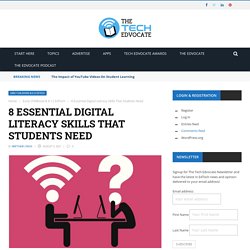
Gone are the days where computer class was spent playing Oregon Trail and creating word processing documents. The networked world in which students exist demands an education that prepares students to produce and consume information in a variety of formats. These formats range from text to images to multimedia. Students need a broad variety of fluencies to be prepared for the 21st-century workforce. Even jobs traditionally thought of us being technology light now require someone who has basic computer skills. Perspectives of Digital Literacies. The Definition Of Digital Literacy. The Definition Of Digital Literacy by Terry Heick When we think of digital literacy, we usually think of research–finding, evaluating, and properly crediting digital sources.
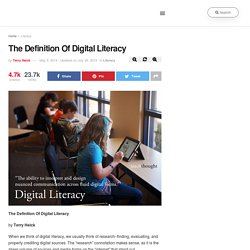
The “research” connotation makes sense, as it is the sheer volume of sources and media forms on the “internet” that stand out. But we are living in a world where the internet is disappearing, replaced by sheer connectivity. Critical Thinking: The Key to Digital Literacy – Fishtree. How should we define digital literacy? Educational leader and PhD student, Lynnea West, explains her research on the principle ways of redefining education through technology, using digital literacy as a key driver: “I would hope that moving forward, we just call them ‘literacies’ and they’re just considered essential components of good literacy practices. We’re living in an online world and digital tools are our reality, so literacy in the broader context is just how we make meaning of what we’re reading or interpreting and how that joins together with our place in the world.”
The concept of digital literacy has been broken down in numerous attempts to define what constitutes a ‘digital native’ and what skills are central to our understanding and interpretation of digital content. Lynnea argues the key to fostering a digital mindset lies in the emphasis of critical thinking. Literacy in the Digital Age. I have identified thirteen literacies that our students need to become well-rounded 21st-century citizens.
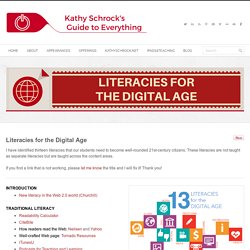
These literacies are not taught as separate literacies but are taught across the content areas. If you find a link that is not working, please let me know the title and I will fix it! Thank you! There is a new book out, Developing Digital Literacies, by Dustin Summey. He presents a well-crafted, technology professional development model that is sound in practice, adaptable, and can be easily implemented at the local level.
Digital literacy. What Digital Literacy Looks Like in a Classroom. Wicked EdTech - Digital Literacy. Literacy Lessons for a Digital World. Knowing the Difference Between Digital Skills and Digital Literacies, and Teaching Both. Digital Literacy is the Most Important Lifelong Learning Tool. Digital literacy in the classroom. How important is it? - ResourcEd. 8 Essential Digital Literacy Skills That Students Need. Perspectives of Digital Literacies. The Definition Of Digital Literacy. Helping Students Become Better Online Researchers.
Your students are probably Internet authorities.
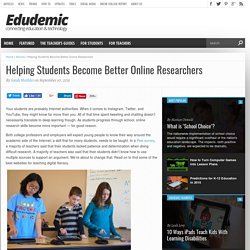
When it comes to Instagram, Twitter, and YouTube, they might know far more than you. All of that time spent tweeting and chatting doesn’t necessarily translate to deep learning though. As students progress through school, online research skills become more important — for good reason. Both college professors and employers will expect young people to know their way around the academic side of the Internet; a skill that for many students, needs to be taught. In a Pew survey, a majority of teachers said that their students lacked patience and determination when doing difficult research.
Image via Flickr by Brad Flickinger For many students, doing research means typing a word or two into a Google search and using information from the first link that pops up. Common Sense Media. Critical Thinking: The Key to Digital Literacy – Fishtree. Wicked EdTech - Digital Literacy. The Power Of I Don't Know. 8 digital life skills all children need – and a plan for teaching them. A generation ago, IT and digital media were niche skills.

Today, they are a core competency necessary to succeed in most careers. That’s why digital skills are an essential part of a comprehensive education framework. Without a national digital education programme, command of and access to technology will be distributed unevenly, exacerbating inequality and hindering socio-economic mobility. What’s your DQ?
Everything Teachers Need to Know about Digital Literacies. Digitality has radically redefined the concept of learning expanding its breadth to unprecedented extremes. New epistemologies have seen the light and with them comes a bunch of new literacies, some call them digital literacies others call them 21st century literacies, but regardless of the nomeclature, these new literacies have rapidly morphed into learning forces driving much of the learning taking place in our current era. The purpose of today's post is to provide you with a list of some great books to help you learn more about digital literacies in terms of what they mean to us as teachers and educators, their theoretical foundation and the social practices constituting these literacies. Links to the books are under the visual. 1- Digital Literacies: Concepts, Policies and Practices (New Literacies and Digital Epistemologies) , by Colin Lankshear (Editor), Michele Knobel (Editor)
What to teach your preschooler about internet safety. Fifteen years ago, parents and caregivers did not have to worry about teaching pre-school aged children about internet safety. A new report prepared for the Children’s Commissioner of England suggests this time has passed. Children now live in a digital age, which means internet access is a daily part of life for many young children around the world. Touchscreen technologies have changed how accessible the internet is for very young children, particularly between the ages of four and five. It’s now quicker and easier to connect to the internet using these technologies, as they don’t require the same level of fine motor and literacy skills used to navigate a mouse and keyboard.
More recently, the Internet of Things has become widespread. Sustaining Digital Literacy - Genius Hour. Untitled. Teach Students about Online Safety with These Excellent Video Tutorials from Google. April 27, 2016 The web provides limitless opportunities for learning, creating, sharing, and exploring the depths of human knowledge. But it is also an unsafe arena where one needs to be equipped with the needed tools and know-how to better stay safe and browse the net securely. Digital literacy model explained. 63 Things Every Student Should Know In A Digital World. What are the 21st-century skills every student needs? The gap between the skills people learn and the skills people need is becoming more obvious, as traditional learning falls short of equipping students with the knowledge they need to thrive, according to the World Economic Forum report New Vision for Education: Fostering Social and Emotional Learning Through Technology.
Today's job candidates must be able to collaborate, communicate and solve problems – skills developed mainly through social and emotional learning (SEL). Combined with traditional skills, this social and emotional proficiency will equip students to succeed in the evolving digital economy. 14 Digital Literacy Activities. Image 1. Las habilidades digitales que nuestros niños deberían aprender. Hace una generación, la tecnología de la información y los medios digitales eran habilidades exclusivas. Hoy, son una competencia clave necesaria para tener éxito en la mayoría de las profesiones. Es por ello que las habilidades digitales forman parte fundamental de un marco de trabajo educativo integral. Sin un programa de educación digital nacional, el dominio y el acceso a la tecnología se distribuirán de manera desigual, exacerbando la desigualdad e impidiendo la movilidad socioeconómica. OCSD K-12 Technology Skills Graph (MASTER) - Google Sheets.
Teaching Keyboarding: More Than Just Typing. While schools have worked hard to integrate computers into the classroom and many do a great job teaching students how they work, many schools do not even consider teaching the art/science of using a keyboard. "Many teachers think it takes nothing to teach keyboarding, but they are wrong," said teacher Carla Cruzan. 8 digital skills we must teach our children. 6 suggestions for teaching information literacy. Keyboarding instruction, touch typing method for schools: Typing Pal Online. Developing Digital Skills in your.. CLASSROOM - my learning diary on the MOOC on EUN About me My name is Rositsa Mineva and I am an ESL/ EFL and technology teacher in the 5th Secondary school in city of Stara Zagora, Bulgaria.
Information Literacy. Google Digital Literacy and Citizenship Curriculum — ikeepsafe.org. Strategic Searching (6-8) Online Safety: A Teacher’s Guide to Dealing with Cyberbullying, Sexting, and Student Privacy. The 8 Digital Literacy Practices Required for 21st Century Learners. Awesome Visual Featuring 13 Important Google Search Tips for Students. Untitled Document. ICT Digital Literacy Assessment and Training Resources. Digital Kindergarten: Best Free Literacy Apps. iPad Apps (The Padagogy Wheel) Resources for Teaching Digital Literacy. Digital Literacy Websites. What Is Successful Technology Integration? “Effective Use of Technology in Education” - A New Discipline to Be Taught. 1135 hoax. Teaching Students Routines for Computer Use. Technology Issues. 6 Technology Challenges Facing Education.
Top 5 Problems with Technology in Education Today. How Should Professors Be Using Classroom Technology?